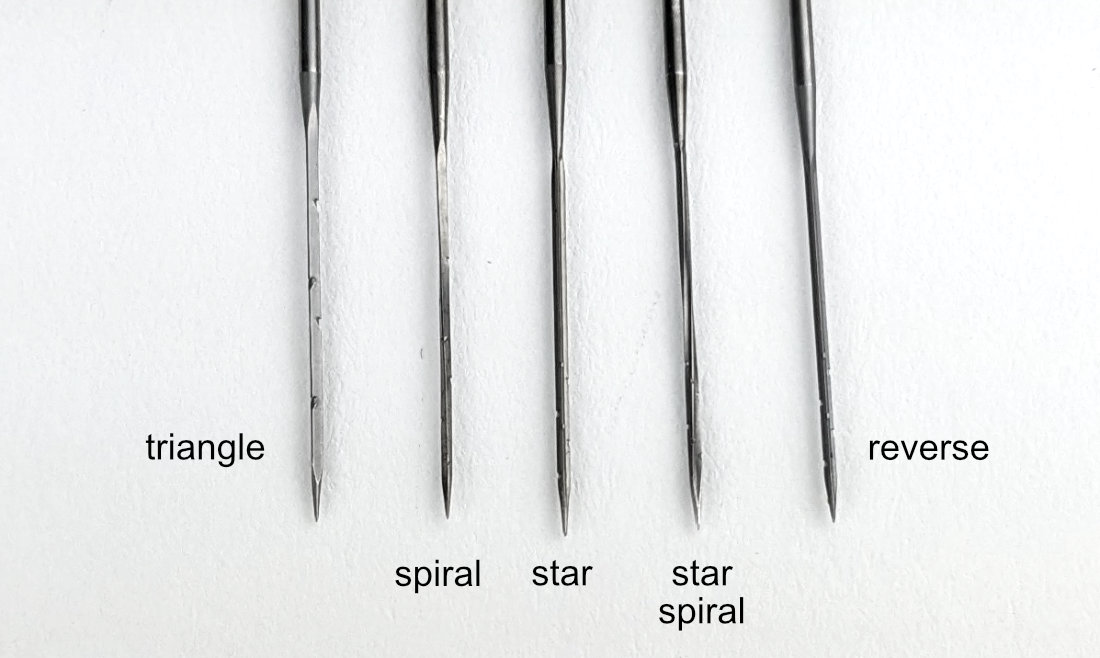Needle felting needles are about 3-3 1/2 inches long. They have a perpendicular bend or handle at one end and a very sharp point at the other. They were originally designed to be used in industrial felting machines. Take a look at the Groz-Beckert animation below to see how a felting needle works in one of these machines.
There are thousands of types of industrial felting needles and each one has a specific purpose.
Types of needles used by crafters
Crafters use a tiny subset of these needles to create their pieces. They may use one needle or a small group of needles in a specialized holder like the Clover Pen Tool.
Felting needles have notches near the pointed tip. The notches create tiny channels that catch strands of fiber and push it down or in the case of “reverse needles”, pull it up and out. I’m going to focus on regular needles first and talk about “reverse needles” a little later.
While the width of the needle determines the gauge, the shape of the needle, the placement of the notches, the direction the notches face, and the number of notches is what determines the type of needle. Let’s take a look at some common types.

- Triangle – triangle shaped needle shaft with regularly spaced notches on three sides
- Spiral or Twist – a triangle needle shaft that has been twisted into a spiral shape
- Star – the needle shaft has four sides with regularly spaced notches. It appears to have a vertical line running down the shaft between the notched sides.
- Star Spiral – a star needle shaft that has been twisted into a spiral shape
- Reverse – a triangle needle with the notches facing the opposite way. It pulls fiber out instead of pushing it in.
Needle gauges
Felting needles for crafters are usually available in the following gauges: 32, 36, 38, 40, and 42. I’ve never seen a 34 gauge needle offered and I have no idea why. It’s a mystery.
32 and 36 gauge needles are referred to as coarse. They are the thickest or roughest of the bunch and do the most “damage” to the fiber. Thus, you see results quickly. They are generally used with core wool to build structure and create a solid base.
38 gauge needles are referred to as medium. They are workhorse needles that you can use for almost anything but very fine work.
40 and 42 gauge needles are referred to as fine. They are the thinnest and most delicate of the group. They are less likely to “damage” the fiber, take longer to felt it, and are used for finishing and detail work.
Look for high quality metal
The metal used in needle felting needles can vary wildly in quality. Beware of cheap needles, especially if you see rust. Rust weakens metal. In my experience, cheap needles tend to be more brittle. Layer rust on top of that and you have a needle which is even more likely to break off in your piece or go flying across the room.
I’m happy to pay the extra dollar or two to work with a quality needle. I prefer Groz-Beckert stainless steel needles. Here are a few sellers that explicitly say their needles are made by Groz-Beckert:
- Desert Breeze Distributing
- The Woolery
- The Felted Desert
- Bam Fiber Works
- Lincolnshire Fenn Crafts
- Sweet Pea Dolls
- Craft Kit Company
- The Makerss (most, but not all, are identified as Groz-Beckert)
Are needle felting assortments worth the price?
It’s fun to say, “I have 20 different needle felting needles” and show people your collection. Many sellers offer expensive, pre-packaged assortments of needles and will imply that they have different uses. But when you read the descriptions, the uses overlap, sound similar, or are felting edge cases. Remember, specialty needles were designed for industrial machine applications.
I fell prey to needle hoarding when I began felting. I bought and still have a couple of these assortments. I don’t use them. I tried the specialty needles once or twice and never picked them up again. They don’t make much of a difference when you are felting by hand.
I only use three to four specific needles: 36 gauge star, 38 gauge star, 40 gauge twist/spiral and 40 gauge reverse needle. You can make anything you want with these four needles. I recommend buying a couple 36 and a few more 38 and 40. Why do I buy more 38 and 40 needles than 36? Because I use the 38 and 40 most often. And since they are thinner needles, they break a little easier than the thicker 36.
You might also want to try a reverse needle. I don’t use reverse needles a lot but they are useful for blending, especially on furry little faces.
——————–
I have included Amazon affiliate links for some of the items above. This means I may earn a small commission (at no extra cost to you) if you click through and make a purchase. Thank you in advance if you decide to support my work using these links. Doing so helps me continue to create content for you!

